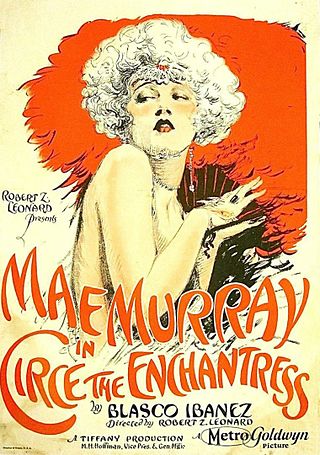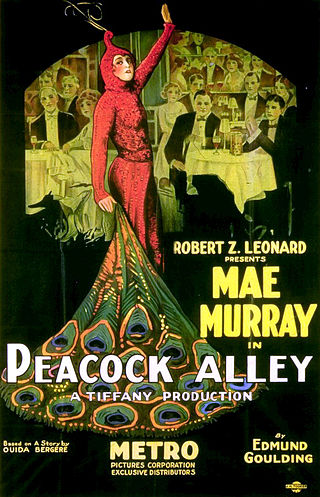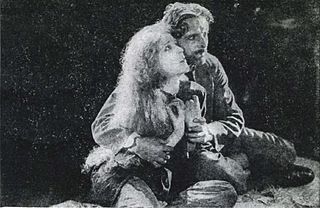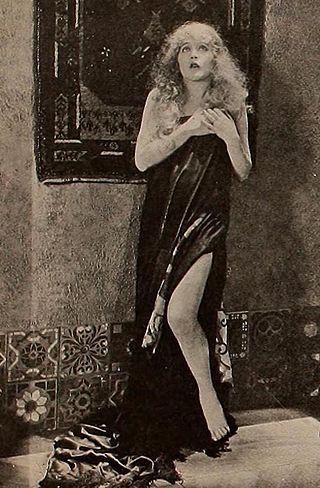
Mae Murray was an American actress, dancer, film producer, and screenwriter. Murray rose to fame during the silent film era and was known as "The Girl with the Bee-Stung Lips" and "The Gardenia of the Screen".

Olivia Joyce Compton was an American actress.

The Merry Widow is a 1925 American silent romantic drama/black comedy film directed and written by Erich von Stroheim. Released by Metro-Goldwyn-Mayer, the film stars Mae Murray, John Gilbert, Roy D'Arcy, and Tully Marshall, with pre-fame uncredited appearances by Joan Crawford and Clark Gable.

Holmes Herbert was an English character actor who appeared in Hollywood films from 1915 to 1952, often as a British gentleman.

Circe, the Enchantress is a 1924 American silent drama film directed by Robert Z. Leonard. The film starred Leonard's then-wife Mae Murray. This was their last collaboration, and they divorced soon after. Considered to be a lost film for decades, a print of Circe, the Enchantress was found at a foreign archive.

The Masked Bride is a 1925 American silent romantic drama film directed by Christy Cabanne and starring Mae Murray, Francis X. Bushman, and Basil Rathbone. It is currently a lost film.

Peacock Alley is a 1922 American silent drama film starring Monte Blue and Mae Murray. The film was directed by Murray's husband at the time, Robert Z. Leonard. An incomplete print survives at the Library of Congress.

Peacock Alley is a 1930 American pre-Code musical romantic drama film directed by Marcel de Sano, and starring Mae Murray and George Barraud. The film is a remake of the 1922 silent film of the same name in which Murray also stars. Aside from Murray being cast in the lead, the remake was largely different from the 1922 silent film. While Murray's character in the 1922 film was named Cleo, she was renamed Claire Tree in this film. George Barraud replaced Monte Blue as the male lead, who is now named Clayton Stoddard.

Idols of Clay is a 1920 American silent drama film directed by George Fitzmaurice and starring Mae Murray and David Powell. A copy of the film survives in the Gosfilmofond Archive in Moscow.

The Right to Love is a 1920 American silent drama film directed by George Fitzmaurice. It stars Mae Murray, David Powell and Holmes Herbert. The film is based on the French novel L'Homme qui assassina, by Claude Farrère and the play of the same name by Pierre Frondaie. A copy of the film is preserved in the Nederlands Filmmuseum.

Flames of Passion (1922) was a British silent film drama directed by Graham Cutts, starred Mae Marsh and C. Aubrey Smith.

Michael G. Ankerich is a biographer whose work focuses on American silent film and early twentieth century actors and actresses. Ankerich's interviews with the last remaining silent film stars were featured in Broken Silence: Conversations With 23 Silent Film Stars (1993) and The Sound of Silence: Conversations with 16 Film and Stage Personalities Who Made the Transition from Silents to Talkies (1998). His biography of silent film actress Mae Murray, Mae Murray: The Girl with the Bee-Stung Lips, was named one of the top 10 must-read film books of 2012.
The Bride's Awakening is a 1918 American silent drama film released by Universal Pictures and produced by their Bluebird production unit. Robert Z. Leonard directed the film and his then-wife Mae Murray was the star. A print of the film is housed at the EYE Institute Nederlands.

The Big Little Person was a 1919 American silent romantic drama film produced and distributed by Universal Pictures. Based on the novel of the same name by Rebecca Lane Hooper Eastman, the film was directed by Robert Z. Leonard and starred his then-wife and muse Mae Murray. Rudolph Valentino, who was credited as M. Rodolpho De Valentina, had a supporting role. The film is now considered lost.
On Record is a 1917 American silent crime drama film starring Mae Murray and directed by Murray's then-husband Robert Z. Leonard. Based on a story by John B. Clymer and Paul West, the film's scenario was written by George D. Proctor. On Record was produced by Jesse Lasky's production company, Jesse L. Lasky Feature Play Company and was distributed by Paramount Pictures. The film's status is currently unknown.

Other Men's Wives is a lost 1919 American silent drama film directed by Victor Schertzinger and written by C. Gardner Sullivan. The film stars Dorothy Dalton, Forrest Stanley, Holmes Herbert, Dell Boone, Elsa Lorimer, and Hal Clements. The film was released on June 15, 1919, by Paramount Pictures.

What Am I Bid? is a 1919 American silent romance film directed by Robert Z. Leonard and starring Mae Murray, Ralph Graves and Willard Louis.

The Scarlet Shadow is a 1919 American silent comedy film directed by Robert Z. Leonard and starring Mae Murray, Martha Mattox and Frank Elliott.

Fashion Row is a 1923 American silent drama film directed by Robert Z. Leonard and starring Mae Murray in a dual role, Earle Foxe, and Freeman Wood. The film involves two Russian sisters emigrate to America. One tries to hide her peasant origins and rises in high society, while the other remains closer to her roots.
Hervey Libbert (1901–1953) was an American art director. He was employed by Tiffany Pictures in the late silent and early sound era on films such as Lucky Boy and Peacock Alley.

















